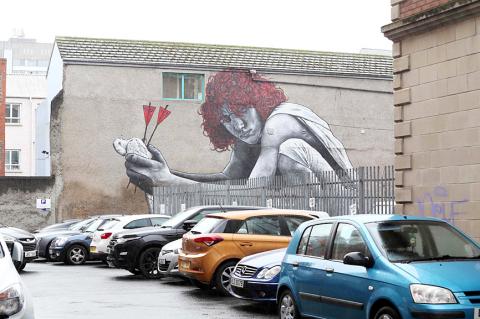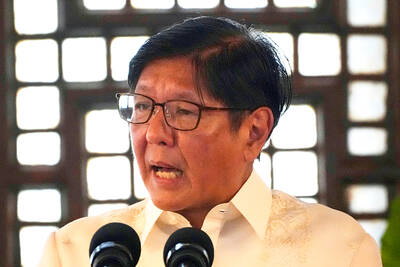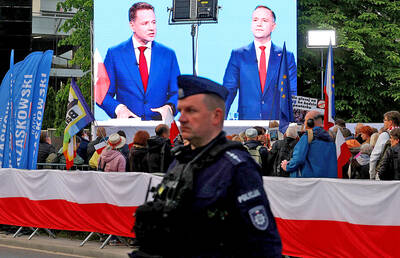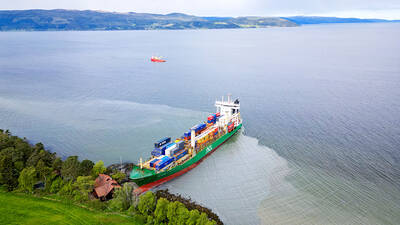From the art of war to the art of peace: For decades Belfast adorned its walls with huge community murals marking the bloody history of the Northern Irish conflict.
However, the murals springing up across the city center have another aim — helping to erase the Catholic-Protestant divide.
“I grew up in front of these political murals and I thought that my goal was to take the city and make it look completely different,” street artist Glenn Molloy, a former DJ, told reporters.

Photo: AFP
Instead of guns, paramilitaries and clenched fists, his murals in the city center feature portraits of celebrities like Jack Nicholson, Bruce Lee and David Bowie.
“I wanted to give something positive, bright, cheerful, something that the people could relate to, rather than to be oppressed,” said Molloy, who is also well-known for painting portraits of the city’s homeless population.
Painted in black and white — with the contours of their faces defined in red — his portraits have earned Molloy the nickname of “Belfast Banksy,” in reference to the famous British street artist.
In the Protestant unionist stronghold of east Belfast, some buildings’ facades hark back to the violence that reigned in the British-ruled province from 1969 to 1998.
“We seek nothing but the elementary right implanted in every man: the right, if you are attacked, to defend yourself,” is written on the facade of a local pub.
A 10m-high painting depicting two paramilitaries wearing balaclavas and armed with a machine gun is right next to the quote.
The intimidating theme can be found on other murals several kilometers away in the former north Belfast bastions of the Irish Republican Army.
“I don’t care if I fall as long as someone else picks up my gun and keeps on shooting” — a quote attributed to guerrilla icon Che Guevara — can be read on a wall next to two bloody clenched fists.
Across the city, in both Catholic and Protestant neighborhoods, the colorful murals helped to demarcate territories.
However, in the city center a motley array of colorful and non-political murals has for the past few years given Belfast a new face.
One shows a car driving through the night, another enormous work depicts a bearded cook with a lobster. Further down, a young melancholic girl is painted in blue.
Overall, more than 100 pieces of street art have been created by artists from Britain, Ireland and the rest of Europe.
Adam Turkington began the movement with a street art festival he created five years ago called “Hit the North.”
“Being non-political in Northern Ireland is being political. Defending aesthetics, beauty, having fun, making the city look better is a pretty powerful message,” he said.
“In Belfast, art and especially street art echoes the silent majority, those who are not voting because they are fed up,” and “the tyranny of a tiny minority” obsessed by divisions and religion, he said.
Although the majority of these murals have no particular message, mysterious French artist MTO in 2014 painted one of the most political pieces on display.
The Son of Protagoras shows a squatting child holding a dove killed by two arrows. One is Catholic, the other Protestant.
“Protagoras is the father of agnosticism. MTO’s message is that religion is ruining this place,” Turkington said.

NO EXCUSES: Marcos said his administration was acting on voters’ demands, but an academic said the move was emotionally motivated after a poor midterm showing Philippine President Ferdinand Marcos Jr yesterday sought the resignation of all his Cabinet secretaries, in a move seen as an attempt to reset the political agenda and assert his authority over the second half of his single six-year term. The order came after the president’s allies failed to win a majority of Senate seats contested in the 12 polls on Monday last week, leaving Marcos facing a divided political and legislative landscape that could thwart his attempts to have an ally succeed him in 2028. “He’s talking to the people, trying to salvage whatever political capital he has left. I think it’s

Polish presidential candidates offered different visions of Poland and its relations with Ukraine in a televised debate ahead of next week’s run-off, which remains on a knife-edge. During a head-to-head debate lasting two hours, centrist Warsaw Mayor Rafal Trzaskowski, from Polish Prime Minister Donald Tusk’s governing pro-European coalition, faced the Eurosceptic historian Karol Nawrocki, backed by the right-wing populist Law and Justice party (PiS). The two candidates, who qualified for the second round after coming in the top two places in the first vote on Sunday last week, clashed over Poland’s relations with Ukraine, EU policy and the track records of their

UNSCHEDULED VISIT: ‘It’s a very bulky new neighbor, but it will soon go away,’ said Johan Helberg of the 135m container ship that run aground near his house A man in Norway awoke early on Thursday to discover a huge container ship had run aground a stone’s throw from his fjord-side house — and he had slept through the commotion. For an as-yet unknown reason, the 135m NCL Salten sailed up onto shore just meters from Johan Helberg’s house in a fjord near Trondheim in central Norway. Helberg only discovered the unexpected visitor when a panicked neighbor who had rung his doorbell repeatedly to no avail gave up and called him on the phone. “The doorbell rang at a time of day when I don’t like to open,” Helberg told television

‘A THREAT’: Guyanese President Irfan Ali called on Venezuela to follow international court rulings over the region, whose border Guyana says was ratified back in 1899 Misael Zapara said he would vote in Venezuela’s first elections yesterday for the territory of Essequibo, despite living more than 100km away from the oil-rich Guyana-administered region. Both countries lay claim to Essequibo, which makes up two-thirds of Guyana’s territory and is home to 125,000 of its 800,000 citizens. Guyana has administered the region for decades. The centuries-old dispute has intensified since ExxonMobil discovered massive offshore oil deposits a decade ago, giving Guyana the largest crude oil reserves per capita in the world. Venezuela would elect a governor, eight National Assembly deputies and regional councilors in a newly created constituency for the 160,000